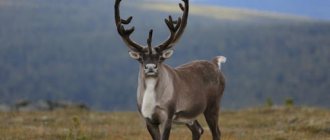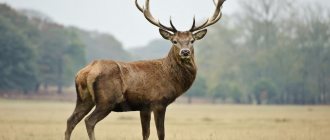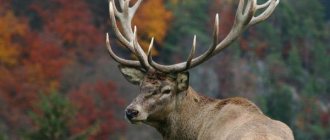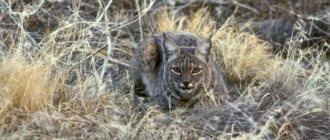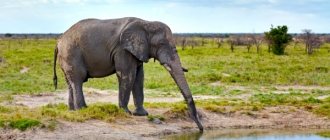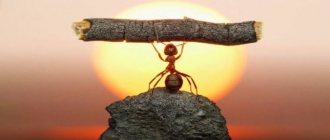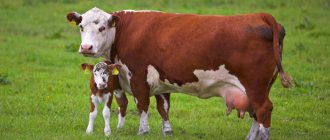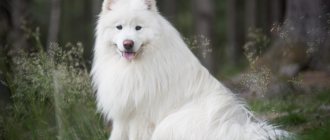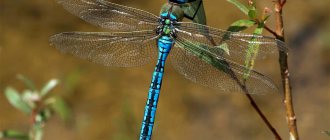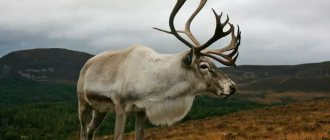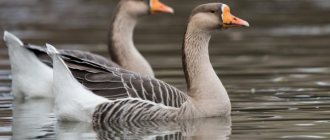Appearance of the animal deer
These beautiful and stately animals, whose heads are often crowned with mighty antlers, have been associated with pristine nature since ancient times, they were depicted on coats of arms and flags, and photos of deer are very popular in all countries of the world.
Representatives of deer are distributed throughout the world, so one or another subspecies can be found almost anywhere on our planet.
Females have their first offspring in the third or fourth year of life. Usually one or two calves are born, which quickly learn to walk and get their first food. Fawns acquire horns around the seventh month of life.
Deer antlers have been highly valued since ancient times. It was because of the horns, to which people have long attributed healing properties, that hundreds of thousands of representatives of these animals were destroyed.
Forest deer are an animal that not only has a beautiful appearance, but also well-developed muscles and long limbs, thanks to which they are able to move rapidly and make huge jumps, which is vital when escaping from predators.
For the most part, deer are distrustful and sometimes even aggressive creatures, driving away potential enemies with a trumpet roar.
Deer have short, yellowish to dark brown fur.
The underbelly and throat are a lighter shade, and many species have a distinctive rump patch—an area of light hair bordered by darker hair. When startled, a deer raises its tail and displays a white patch on its rump to alert other deer nearby.
In addition to displaying a spot on the rump, deer communicate through sound and smell, and they produce a variety of vocalizations, from the roar of a red deer to the whine of a muntjac. Deer also have scent glands near their eyes, which they use to mark their territory on branches and twigs. Dung is also used as a territorial marker. Males will smell the female's urine to see if she is in heat.
Deer diet
Deer, like many other herbivores, feed mainly on leaves, grass and the bark of young trees. They do not hesitate to add mushrooms, berries, mosses and nuts to their diet, which contributes to the rapid development and growth of young individuals.
Necessary minerals and salts are obtained by finding natural salt deposits in the soil, which allow you to replenish the required balance of microelements.
Interesting Facts
Always curious to know about interesting facts about reindeer:
- Now, like many years ago, a wonderful holiday is celebrated - Reindeer Herder's Day. During the holiday, reindeer sled riding competitions are held.
- When walking, these animals make sounds that resemble knocking.
- This is the only species in which the females have horns.
Reading interesting facts about reindeer will tell a person little; you just need to see them in person, touch their warm fur, hear their breathing when they run in a sled. Otherwise they cannot be understood.
Families and species of deer
Currently, there are several global families of deer, which differ quite significantly from each other.
The first family includes representatives of the so-called Old World deer - Cervinae. Now it includes more than thirty different subspecies and varieties, representatives of which can be found throughout the planet.
This name originates from the place of origin of the specified subspecies, but now, thanks to human efforts, it has become widespread throughout the globe.
Old World Deer
In general, Old World deer are divided into two main large subgroups: red and spotted.
Red deer
Representatives of this species live mainly in Europe and Asia, but some individuals have also been spotted in Africa. In fact, the subgroup of red deer includes many species of these amazing animals, such as deer, wapiti, wapiti, Crimean deer and others.
In total, the group of red deer has about twenty different subspecies, which differ quite significantly from each other in appearance and character.
Deer of the Maral breed
For example, the deer is considered one of the most standard representatives of deer. This is a large animal, capable of growing up to two to three meters in length and up to one and a half meters in height (not counting the impressive horns that crown the heads of representatives of this species). An adult male deer weighs about three hundred kilograms.
European deer
European deer usually do not grow to such dimensions. But the antlers of a deer are truly luxurious, reminiscent in their shape of a tree crown or a crown. It was thanks to them that the European look gained its well-deserved popularity.
Bukhara deer
One of the smallest representatives of red deer is the Bukhara deer. Adults usually do not grow more than one hundred kilograms and do not have impressive external dimensions.
These differences between representatives of one large group occur due to different living conditions, which radically change the diet, natural enemies and lifestyle of animals in general.
What all red deer have in common is that, regardless of the time of year, they do not change the color of their skin and do not become covered with spots for better camouflage. The colors are dominated by yellow, light brown and grayish tones, which cover almost the entire body. There is a noticeable white spot on the loin, which is the calling card of this species.
Sika deer
Most sika deer are not as large as their noble counterparts. They grow to about two meters in length and weigh no more than one and a half centners. But the most important difference is the color of the skins.
In warm seasons, the bodies of sika deer present a palette of brownish-reddish colors, which is dotted with a huge number of white spots. In winter, the color becomes more uniform and less striking.
Sika deer live mainly in Asia and Japan; they were introduced and successfully adapted to life in the Caucasus. The life of a deer lasts approximately twenty years.
The most famous species of sika deer are axis, fallow deer, and muntjac. In total, there are more than fifteen species that scientists classify as sika deer.
Gon
In the natural environment, males become ready to reproduce at the age of 4-5 years, and females at 3 years. When kept in captivity, cases of offspring appearing at an earlier age have been recorded.
The duration of pregnancy depends on the age of the animal: a young female red deer carries a baby for about 7 months, and an adult a little more than 8. Before giving birth, the female separates from the group and looks for a secluded place.
Usually one fawn is born, weighing from 6 to 8 kg. The baby has a spotted coloring that lasts up to 3 months. In the first days, the cub hides in the grass, and the mother grazes nearby and periodically feeds it with milk. After a week, the baby is already confidently standing on his feet and follows the female everywhere. By 3-4 weeks, he is able to graze on his own, but continues to be fed with mother’s milk for several more months, and sometimes until she has new offspring.
MOLE
Features of mating behavior
The mating season of red deer takes place in several stages:
- the beginning of the rut and the male’s choice of a site—leok;
- formation of groups of males and females;
- pairing;
- end of the rut.
The beginning of the rut depends on the climatic conditions in the reindeer habitat. In the northern regions it begins in early September, in warmer climate zones - at the end of September or beginning of October. Each sexually mature male chooses a so-called lek - an area where mating will take place. Typically, places near streams, forest clearings, and hills are chosen as currents. In the selected territory, the male rubs his horns against the trees and tears up the ground with his hooves.
After choosing a site, the males begin to roar, calling for females. The roar of a male red deer during the rut can be heard for 3-4 kilometers. The nature and timbre of the sounds produced differs among different subspecies of deer.
Mature females living nearby move closer to the leks. The formation of groups for mating begins with the first frost and lasts up to two weeks. During this period, up to 3-5 females gather near each male, which he watches and does not allow other contenders to approach. Often, during skirmishes over the possession of a “harem,” males inflict mortal wounds on each other.
What sounds do deer make?
Once the females are covered, the mating season ends and the females return to their herds.
KANGAROO
New World deer
Another group is the New World deer or Capreolinae. Unlike the former, the habitat of this group is geographically limited to the New World.
American deer
The most famous representatives of this subgroup are American deer. Their habitat is limited to North America.
There are two subspecies of American deer: Virginian (the name comes from their habitat, Virginia) and burro, so named because of their massive donkey-like ears. External color varies from dark brown to bright yellow.
Swamp and pampas deer
Another type of American deer is the swamp and pampas deer. Their diet consists mainly of low-growing and marshy vegetation. Small size and calm character are a distinctive feature of these species.
Pudu deer
The smallest deer animal on our planet is the pudu. They live in Chile. The weight of an adult individual is no more than ten kilograms, and the height at the withers is less than half a meter.
Andean deer
Andean deer are another and the most famous representatives of the family. These are quite large animals with a strong body and relatively short legs. Their color is light brown, and their horns resemble the letter U. In addition, this species became famous due to its image on the coat of arms of Chile.
Independent species of deer
Scientists distinguish roe deer separately from other species. They live in vast areas of Eurasia. These are graceful and beautiful animals with a long neck and powerful legs. They stand out for their unusually shaped horns - they consist of three branches and are completely covered with burs.
Caribou or reindeer
Caribou or reindeer are one of the most unusual representatives of their family. Their peculiarity is that both sexes have horns, unlike the vast majority of other animals. Wide, powerful hooves prevent them from falling into loose snow or swampy soil.
These animals were tamed by many northern peoples in ancient times, and to this day they are a source of milk and skins that the peoples of the far north use in their everyday life.
Water deer (musk deer)
differs from its brothers in the absence of horns. But their uniqueness lies in their fangs, which protrude several centimeters from the males’ mouths. They live in China and Korea.
Moose: elk and American
Moose are a family of deer animals that can be considered separately from the general group.
The European elk (elk) has large dimensions (up to three meters in length) and weighs more than half a ton. A powerful body with strong legs allows you to reach speeds of up to 60 kilometers per hour. Moose antlers resemble a plow in shape, which is where the name comes from.
The American counterpart does not lag behind the European one in size. It has horns larger and more massive than those of the elk. Prefers to live in mountainous northern areas, away from humans. Its habitat is not limited to North America; it also lives in the territories of Russia, China, and Mongolia.
Reproduction
Pregnancy in females lasts 6-9 months, depending on the species. As a rule, only one cub is born, rarely two. Almost immediately after birth, the baby stands on its feet. And a few weeks later he nibbles the grass and young shoots of the plants. However, he drinks his mother's milk for the entire first year of his life.
From birth, small fawns have a beautiful spotted color. It helps camouflage from predators. Touching photos of baby deer, published in specialized nature magazines and on the Internet, provide an opportunity to get a closer look at the life of these amazing animals.
A year later, small tubercles can be seen on the males’ heads - the first small horns. In subsequent years, branches appear on the horns, and each new horn becomes stronger and more massive.
Natural enemies of deer in the wild
Since all deer are herbivores, they naturally become prey for large predators that live in the same territory with them. One of the most terrible enemies of a deer is the wolf.
Despite the fact that a deer is usually larger and faster than a wolf, a pack of predatory animals can easily overwhelm even the most energetic cervid. Other dangerous enemies include other large predators: bear, tiger, puma.
Human use
The life of northern peoples has always depended on reindeer. Domestic ones were used to transport goods, while wild ones were hunted. It was believed that the more deer heads a family had, the richer it was.
Plagues are made from the skins, and clothing is sewn for both women and men. They make warm and comfortable winter shoes.
Meat, entrails and blood are used to make food. The milk of females is also used in cooking.
Amazingly beautiful jewelry is made from horns and hooves. Horns are also used in medicine, as they have healing properties. Scientists were also interested in these medicinal properties, and they found that the powder prepared from the horns contained a remarkable gene responsible for the renewal of bone tissue. As a result, drugs were produced that could stimulate a person’s internal mental and physical reserves of strength.
